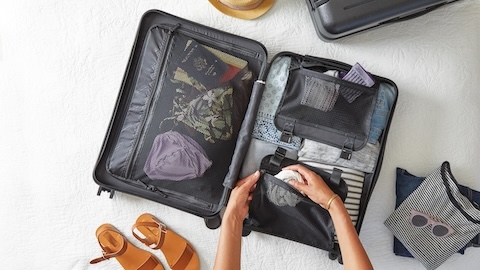Updated on June 6, 2025 to reflect latest rewards accumulated and available offers.
Credit card travel rewards — also known as travel hacking — have been a key part of our strategy for traveling the world affordably since we began full-time travel in 2018. Almost all of our long-haul flights are booked using points, saving us thousands of dollars each year. We even treat ourselves to the occasional 5-star hotel stay, thanks to credit card hotel rewards. In this guide, we’ll walk you through how travel rewards work, how to start using them effectively, and which cards offer the best value for beginners.
What Are Travel Rewards and How Do They Work?
Travel rewards—also known as credit card rewards or “travel hacking”—involve opening specific credit cards to earn large sign-up bonuses in the form of travel points or miles. These bonuses are often valuable enough to cover the cost of an international flight. In many cases, that means one new card = one free flight. To unlock the bonus, you’ll typically need to meet a minimum spending requirement (e.g., spend $3,000 within 3 months). Once earned, these points can be redeemed for flights, hotels, or other travel expenses—though you’ll still be responsible for taxes and fees.
Important: most of these credit card offers are only available to U.S. citizens or residents, so eligibility may vary depending on your location.
The 3 Types of Travel Rewards You Should Know
- Airline and Hotel Rewards
These come from co-branded credit cards tied to a specific airline or hotel chain. Points earned can typically only be used within that brand’s loyalty program.
Examples: Delta SkyMiles® Credit Card, Marriott Bonvoy Boundless® Credit Card - Fixed-Value Rewards
These rewards have a set redemption value—usually 1 cent per point—and can often be used to “erase” travel purchases directly from your statement. Simple, predictable, but less flexible.
Examples: Capital One Venture, Barclaycard Arrival Plus - Transferable Points
These are the most flexible—and often the most valuable—because you can either book travel through the card issuer’s portal or transfer points to a variety of airline and hotel partners for better redemption rates.
Examples: Chase Sapphire Preferred®, Chase Sapphire Reserve®
If you’re ready to start earning rewards, we’ve curated a list of the best current credit card offers to help you maximize your points from day one. These are the same cards we’ve personally used to fly internationally and stay in luxury hotels for free. Check out our top picks here.
Tips to Maximize Travel Rewards
Here are our pro tips to maximize your travel rewards:
- Always Pay in Full. Seriously – do not play the points game if you’re carrying a balance. Interest charges will erase any rewards and wreck your credit. Get your finances solid first.
- Know the Chase 5/24 Rule.
If you’ve opened 5+ credit cards (from any bank) in the last 24 months, Chase won’t approve you for new cards. Since Chase Ultimate Rewards are some of the most valuable out there, prioritize Chase cards before hitting that limit. - Set a $500 Minimum Value Bar.
Don’t bother with cards that offer under $500 in total value after annual fees. Your 5/24 slots are limited—treat each one like a valuable asset. - Be Smart About Annual Fees.
Only pay an annual fee if the ongoing perks outweigh the cost. Many cards waive the first-year fee—use that time to evaluate long-term value and feel free to close the card if the annual fee doesn’t make sense. - Track Everything in One Place. We like to use a spreadsheet to at minimum where we record:
- Bank + Card Name
- Personal or Business
- Reward Type (e.g. transferable points, airline miles)
- Annual Renewal Date
- Bonus Offer + Spend Requirement
- Deadline to Meet Spend
- Bonus Received? (Yes/No)
- Keep Open Long-Term? (Yes/No)
- Tag-Team with a Partner. Alternate signups between you and your partner (or a friend) to double-dip on bonuses—especially for limited-time offers.
- Leverage Business Cards Strategically. Business cards don’t count toward the Chase 5/24 Rule. Use them to extend your runway without burning through personal card slots.
- Rotate your cards. Most issuers let you reapply for the same card 24–48 months after earning the original sign-up bonus—letting you earn the bonus again.
- Know When to Pay Cash Instead. Not every redemption is a good one. If the cash price is low, save your points for high-value redemptions.
What are the best cards to get started?
We highly recommend that you start with the top Chase card, the Chase Sapphire Preferred, to plan for the 5/24 rule. The Chase Sapphire Preferred has a much more approachable annual fee to get started than the Chase Sapphire Reserve. It’s also a great first credit card for travel rewards because the points are transferrable as cash value on their portal or can be transferrable to many partner airline and hotel programs.
If you already have this card and are looking for other suggestions, please check out our Credit Cards page where we put the latest credit cards offers we’ve been recently using. And if you’d like to stay updated on our finds, we suggest that you sign-up for our newsletter where we share the latest offer from the cards we’ve been recently opening.
How much in travel rewards did we earn and redeem in one year?
Now that we’ve introduce the notion of Travel Rewards and how to best use them, you can take a look at our actual travel rewards earnings and redemptions in 2024. In this detailed breakdown, we’ll show you which credit cards we opened, how many rewards points we earned, and exactly how we redeemed them.
Note: To read all of our annual travel rewards earnings and redemption reports, check out the full archive here.
Our bottom line
Thanks to credit card travel rewards, we’ve been able to travel the world since 2018—often flying internationally for free. With the right strategy and a focus on sign-up bonuses, you can earn thousands in rewards each year and make your travels far more affordable.
Just one important reminder: travel hacking only works if you always pay your credit card balance in full and on time. If you carry a balance, the interest will wipe out any rewards.
Now we’d love to hear from you—have you used credit card bonuses to score free flights or hotel stays? Or do you have a travel rewards tip we might’ve missed? Drop your thoughts in the comments below!
Happy & safe free travels!




20 Comments
Franc · November 19, 2019 at 11:40 am
Are you saying that the initial sign up reward is what you use, and then you no longer use the card for that purpose, or are the points no longer available on that basis, i.e. less points etc.
Mr. Nomad Numbers · November 19, 2019 at 12:00 pm
Hi Franc. We sign up for the card just to get the points that come with sign up bonuses and then usually stop using the card and look at the next one to open. Hope this helps. Let us know if you have more questions. If you can tap into travel rewards, it’s a great way to save a ton lot of money while traveling 🙂
How to slow travel the world at discount: our best AirBnB tips – Nomad Numbers · March 11, 2019 at 2:06 am
[…] How to fly the world for (almost) free with Travel Rewards […]
Cost of our nomad living in Quebec City – Nomad Numbers · March 18, 2019 at 12:37 am
[…] How to fly the world for free with Travel Rewards […]
How we spend our money – Nomad Numbers · March 25, 2019 at 4:12 am
[…] How to fly the world for free with Travel Rewards […]
Becoming Nomadic Through Real Estate investment – Nomad Numbers · October 21, 2019 at 3:57 am
[…] How we fly the world for free with Travel Rewards […]
Destination Report: Kotor - Part Two: Cost of Nomad Living - Nomad Numbers · January 16, 2020 at 7:22 am
[…] How to fly for (almost) free […]
Destination Report: Lisbon - Part Two: Cost of Nomad Living - Nomad Numbers · January 16, 2020 at 7:24 am
[…] How to fly for (almost) free […]
Destination Report: Chiang Mai - Part Two: Cost of Nomad Living - Nomad Numbers · January 16, 2020 at 7:28 am
[…] How to fly for (almost) free […]
Cost of our nomad living in San Miguel de Allende - Nomad Numbers · January 16, 2020 at 7:30 am
[…] How to fly for (almost) free […]
Cost of our nomad living in Puerto Vallarta - Nomad Numbers · January 16, 2020 at 7:35 am
[…] How to fly for (almost) free […]
Cost of our nomad living in Montreal - Nomad Numbers · January 16, 2020 at 7:36 am
[…] How to fly for (almost) free […]
Living on $7k to $16k a Year, Pursuing Freedom through Nomadic Living & the Power of Being Intentional - Nomad Numbers · February 17, 2020 at 10:29 am
[…] How to fly for (almost) free […]
[Interview #010] Semi-retirement at age 33 for better work-life balance - Nomad Numbers · March 1, 2020 at 2:25 pm
[…] How to fly for (almost) free […]
Destination Report: Koh Lanta - Part Two: Cost of Nomad Living - Nomad Numbers · March 2, 2020 at 9:14 am
[…] How to fly for (almost) free […]
Destination Report: Porto - Part Two: Cost of Nomad Living - Nomad Numbers · March 2, 2020 at 9:23 am
[…] How to fly for (almost) free […]
Cost of our nomad living in Aruba: Staying in paradise for 4 weeks can be cheaper than staying at home - Nomad Numbers · March 2, 2020 at 9:27 am
[…] How to fly for (almost) free […]
2nd Year of Nomadic Travel Spending Report - Still half the cost plus unexpected pandemic change of plans - Nomad Numbers · July 8, 2020 at 1:34 am
[…] How to fly for free […]
Destination Report: Penang - Part Two: Cost of Nomad Living — Nomad Numbers · September 19, 2021 at 3:24 pm
[…] How to fly for free […]
How we booked 6 international one way tickets + 5 nights at a high-end resort in Fiji for $400 — Nomad Numbers · May 15, 2022 at 10:16 pm
[…] How to fly for free […]